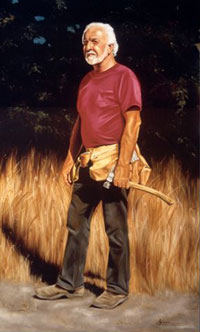
Health & Happiness to You and Yours... Judy Brose
Human Version of Mad Cow Disease Usually Not Linked to Diet
By Malcom Ritter (AP Science Writer)
Since the latest mad cow disease scare hit the headlines, the calls have been coming in to the Creutzfeldt-Jakob Disease Foundation: My loved one dies of CJD, people say. Could it have been something he ate?
The news is full of concern that people can develop the brain disease by eating food products from cattle with mad cow disease.
But thats not what causes most cases of CJD.
Only about 150 cases of the human disease linked to mad cow, known as variant CJF, have been counted worldwide since it was first formally described in 1996. ( The vast majority of those cases are in the United Kingdom.) But every year, about 250 people in the United States alone are diagnosed with classic CJD, a disease known for 80 years.
Though both forms of CJD are rare and always fatal, they do differ in several ways: in the age of their victims, the speed in which they kill, and the initial symptoms.
The cause of classic CJD is unknown 85 percent of the time. The remaining cases are either caused by inheriting a genetic mutation or acquired through medical procedures that used contaminated equipment or tissues.
Florence Kranitz, executive director of the CJD foundation, said she tells inquiring families that CJD in older people is generally not linked to mad cow disease. In fact, the age difference between classic and variant CJD is striking, said Dr. Ermian Selay, a medical epidemiologist at the Centers for Disease Control and Prevention.
The classic version typically strikes people in their 60s and 70s; half the patients dies by age 68, he said. The variant kind is a young persons disease, with half its victims dying by age 28.
Symptoms also tend to play out differently in the two kinds of disease. In variant CJD, the early symptoms tend to be mostly psychiatric problems, like depression, withdrawal and anxiety, and patients often complain of pain or numbness or pins-and-needles sensation. In classic CJD, early symptoms are usually neurological, like trouble standing or walking properly, involuntary jerking and speech abnormalities, along with an erosion of mental abilities.
Its a dreadful disease, in part because one can see the loss of mental abilities almost from day to day.
Dr. Richard Johnson - Johns Hopkins University School of Medicine
Eventually, patients become unable to move or speak and they typically enter a coma before death.
One other difference is that classic CJD kills much faster. The variant form takes about 14 months from the first symptoms to kill half its victims. The classic form takes just six months, and it kills about 90 percent within a year.
Its a dreadful disease< in part because one can see the loss of mental abilities almost from day to day, said dr. Richard Johnson of the Johns Hopkins University School of Medicine.
Johnson recalled an acquaintance with the disease. One Sunday, the man noticed his tennis backhand was off. Within weeks, he was having trouble doing his work. A few weeks later, he could not remember his childrens names. A few weeks after that, he could no longer recognize his wife.
The fast course of classic CJD makes it stand out from Alzheimers disease and other disorders, and it can usually be diagnosed from its symptoms and lab tests while the patient is living, Johnson said. If necessary, examination of brain tissue from a biopsy or autopsy can provide a definitive diagnosis, by revealing a characteristic sponge-like appearance under a microscope.
Federal health officials say about half of Americans who die from CJD are autopsied, and increasing that rate could help research into the disease. Autopsy findings can also distinguish between variant CJD and the classic form.
Of course, its variant CJD that continues to capture public attention.
Federal officials say American beef is safe despite the latest mad cow diagnosis, noting that the rogue proteins called prions that cause both mad cow disease and variant CJD arent found in cow muscle tissue, the source of rogue proteins called prions that cause both mad cow disease and variant CJD arent found in cow muscle tissue, the source of roasts, steaks and other beef cuts. (Prions are found in the brain, spinal cord and small intestine, and on Tuesday the federal government announced new rules for keeping these parts out of the food supply).
But last year, California scientists reported that mice exposed to prions did accumulate them in muscle. They called for major efforts to look for prions in muscle of infected livestock.
Belay cautioned that the lab results dont necessarily apply to cattle. Whats more, he said, other researchers have found that muscle tissue from infected cows couldnt spread disease when put into other animals. Thats pretty reassuring, Johnson said.
